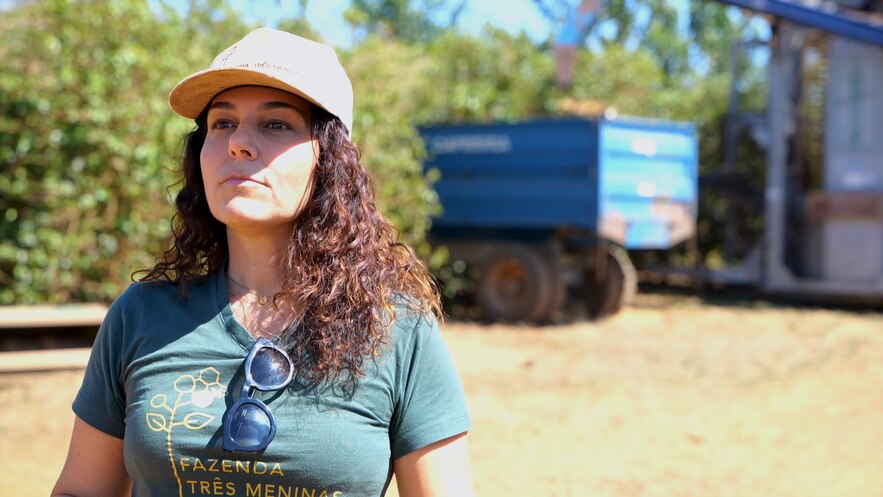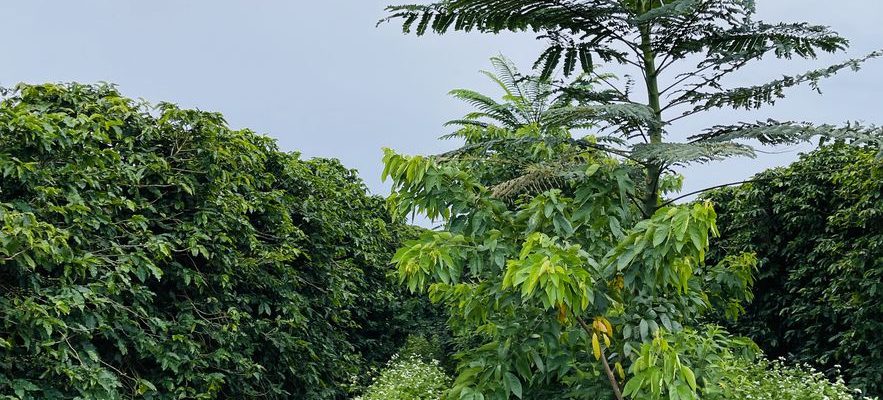There’s something wrong with this coffee plantation. In Minas Gerais, Brazil’s leading coffee-growing region, we usually find neatly dressed fields, on perfectly virgin reddish soil. But here, we see some weeds between the rows, a beehive a little further away, over there, trees sticking out… “Come this way,” invites Paula Curiacos, kneeling between two rows, near the weeds. Thermometer in hand, the owner of the place tells us that the earth here is 15 degrees cooler than on the virgin path which leads to her farm. “A living earth is an earth full of oxygen, which breathes, and which requires much less water and fertilizer. For us, the credo is simple: the earth must be covered all the time”.
We then understand that the bushes are in reality a subtle mixture of buckwheat and millet, that the trees that protrude are there to enrich the soil and provide adequate shade, and that the bees, sensitive to any variation in the weather, serve as Paula’s climate sentinels. “It’s not poetry, it’s science,” insists the coffee farmer, who has lived in Patrocinio with her husband since 2006. “If we don’t develop our agriculture, there will be no future here.” .
Coffee is one of the crops most threatened by global warming. The plants are fragile, growing only in subtropical zones, most often between 800 and 2000 meters above sea level. And this is even more true for Arabica, the most popular variety on the Western market, but less resistant to climatic hazards than its cousin Robusta.
The coffee plantation of Paola Curiacos, in Minas Gerais (Brazil)
© / Tres Meninas
According to a complementary study carried out this year by Doug Richardson, an Australian climatologist, “increasing temperatures harm production”. But that’s not all. “We have demonstrated that abnormal climatic events, such as droughts, heatwaves or torrential rains, are increasing and affecting the smooth running of harvests. We were struck by the extent to which these phenomena occurred everywhere at the same time. in subtropical zones,” he told L’Express. In Brazil, coffee production fell by 7.7% between 2021 and 2022. In his reportthe International Coffee Organization explains it in particular by a very unusual frost for the region.
“We were taken for crazy people”
On a global scale, the outlook is cause for concern: 25 million families live off this harvest. Most often, they are small farmers. Moving their plantations higher in altitude or converting to sustainable agriculture is sometimes expensive, and initially causes a loss of income for these families. Beyond that, an entire industry must roll up its sleeves to ensure the sustainability of this raw material at the origin of a global market worth 120 billion euros. “The sector is at risk,” admits Julie de Ferron, communications director at Nespresso. “We want to help all of the coffee growers with whom we work to transition to regenerative agriculture.” The Swiss giant has also recruited more than 400 agronomists over the years, who help farmers make their plantations more resilient and less demanding on fertilizer and water. Players in the sector such as Lavazza or Malongo are also committing to sustainable trajectories. At IllyCaffé, we have even just announced the launch of a ground Arabica from regenerative agriculture.
“In Brazil, there are pioneers, whom we have supported for decades,” continues Julie de Ferron. Paula Curiacos is one of them. The Patrocinio operator sold them 30% of her production last year. “When we arrived seventeen years ago, other producers in the region thought we were crazy. Now they come to us for advice. We have built a model to follow,” she smiles.

Paula Curiacos, coffee farmer in Patrocinio (Brazil)
© / The Express
The road remains long. Of the approximately 300,000 Brazilian producers, 10 to 15% practice regenerative agriculture, estimates a Brazilian journalist specializing in the agricultural world. In other words, the intensive method still holds the reins firmly. The RainForest Alliance association deplored in 2019 that three quarters of coffee sold worldwide still lacked any certification or sustainable production standards. “At this stage, efforts are insufficient to counter climate change,” recalls Doug Richardson. For coffee, hope lies in more sustainable agricultural practices. But there are reasons to fear that production will become scarce, and that , for consumers, prices are soaring.”
